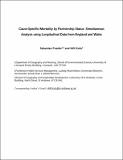Files in this item
Cause-specific mortality by partnership status : simultaneous analysis using longitudinal data from England and Wales
Item metadata
| dc.contributor.author | Franke, Sebastian | |
| dc.contributor.author | Kulu, Hill | |
| dc.date.accessioned | 2018-06-25T14:30:52Z | |
| dc.date.available | 2018-06-25T14:30:52Z | |
| dc.date.issued | 2018-08-09 | |
| dc.identifier | 253407353 | |
| dc.identifier | 1573b841-74f9-48ce-a5af-a585b77c8751 | |
| dc.identifier | 85049151198 | |
| dc.identifier | 000445084200013 | |
| dc.identifier.citation | Franke , S & Kulu , H 2018 , ' Cause-specific mortality by partnership status : simultaneous analysis using longitudinal data from England and Wales ' , Journal of Epidemiology and Community Health , vol. 72 , no. 9 , pp. 838–844 . https://doi.org/10.1136/jech-2017-210339 | en |
| dc.identifier.issn | 0143-005X | |
| dc.identifier.other | ORCID: /0000-0001-8808-0719/work/75996973 | |
| dc.identifier.uri | https://hdl.handle.net/10023/14550 | |
| dc.description | SF’s research was supported by the Economic and Social Research Council (ES/J500094/1) through the North West Doctoral Training Centre Social Statistics pathway (PhD project: ’Health, Mortality and Partnership Status: Protection or Selection’). He also held an Advanced Quantitative Methods (AQM) enhanced stipend. | en |
| dc.description.abstract | Background: This paper examines cause-specific mortality by partnership status. Although non-marital cohabitation has spread rapidly in industrialised countries, only a few studies have investigated mortality by partnership status and no recent study has investigated cause-specific mortality by partnership status. Methods: We use data from the Office for National Statistics Longitudinal Study and apply competing risks survival models. Results: The simultaneous analysis shows that married individuals have lower mortality than non-married from circulatory, respiratory, digestive, alcohol and accident related causes of deaths, but not from cancer. The analysis by partnership status reveals that once we distinguish premarital and postmarital cohabitants from other non-married groups, the differences between partnered and non-partnered individuals become even more pronounced for all causes of death; this is largely due to similar cause-specific mortality levels between married and cohabiting individuals. Conclusions: With declining marriage rates and the spread of cohabitation and separation, a distinction between partnered and non-partnered individuals is critical to understanding whether and how having a partner shapes the individuals’ health behaviour and mortality. The cause-specific analysis supports both the importance of selection into partnership and the protective effect of living with someone together. | |
| dc.format.extent | 1369547 | |
| dc.language.iso | eng | |
| dc.relation.ispartof | Journal of Epidemiology and Community Health | en |
| dc.subject | Mortality | en |
| dc.subject | Partnership status | en |
| dc.subject | Causes of death | en |
| dc.subject | Survival analysis | en |
| dc.subject | Competing-risks models | en |
| dc.subject | England | en |
| dc.subject | H Social Sciences (General) | en |
| dc.subject | HQ The family. Marriage. Woman | en |
| dc.subject | Social Sciences(all) | en |
| dc.subject | 3rd-DAS | en |
| dc.subject | SDG 3 - Good Health and Well-being | en |
| dc.subject.lcc | H1 | en |
| dc.subject.lcc | HQ | en |
| dc.title | Cause-specific mortality by partnership status : simultaneous analysis using longitudinal data from England and Wales | en |
| dc.type | Journal article | en |
| dc.contributor.sponsor | Economic & Social Research Council | en |
| dc.contributor.institution | University of St Andrews. School of Geography & Sustainable Development | en |
| dc.identifier.doi | 10.1136/jech-2017-210339 | |
| dc.description.status | Peer reviewed | en |
| dc.identifier.grantnumber | ES/K000446/1 | en |
This item appears in the following Collection(s)
Items in the St Andrews Research Repository are protected by copyright, with all rights reserved, unless otherwise indicated.

